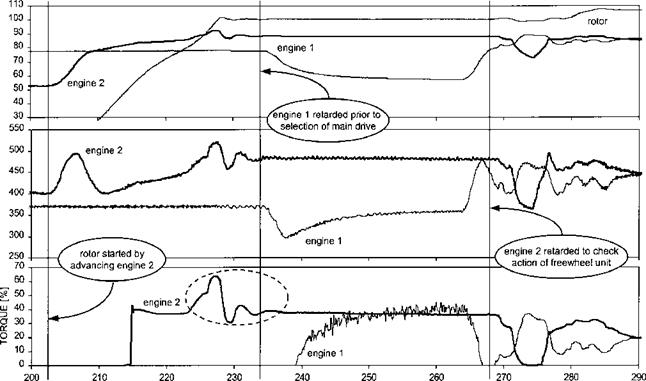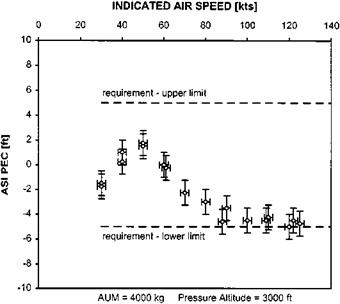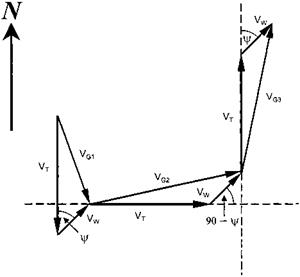Transient torque response
Allied to the transient droop characteristics of a rotor system is the transient torque response to power demands made by the rotor system. A rapidly reacting governing system may effectively prevent transient droop but may create a problem by producing a large torque spike. An excessive torque response may restrict the agility of the rotorcraft as fully as excessive transient droop would. Part of the assessment of the torque response is to assess any lag in the torque indication system. If the indication lags the actual value significantly then this can lead to the transmission limit being exceeded when the pilot selects a high power setting. This problem can often lead to operational pilots being unwilling to manoeuvre the aircraft with any more than moderate aggression which may have a serious effect on the conduct of the role. The test techniques and mission tasks used to test the transient torque response are identical to those used for transient droop testing.
7.4.6.2 Transient overswing
Transient overswing testing is conducted to examine the rate at which the governing system is able to reduce the fuel flow to the engine(s) with rapid decreases in collective pitch. If the system is not able to react quickly enough the power output from the engines will momentarily exceed the power required by the rotor causing the rotor speed to increase.
Transient overspeed testing is conducted in a similar way to transient droop testing. Rapid collective lever lowering is made from the collective position which gives 95% of maximum continuous torque to the lever fully down position. As in transient droop testing the rate of lever movement is increased incrementally starting with a minimum of a 5-second lowering and then reducing by one second for each subsequent test point. The maximum transient rotor speed is recorded together with the minimum normal acceleration achieved. The decision on whether to proceed to the next test point depends on the proximity to the rotor speed and ‘g’ limits. Once the transient rise in rotor speed has been observed the pilot may have to raise the collective lever to control any subsequent rise in NR caused by entering flight idle glide.
The operational effect of transient overswing is assessed by conducting mission tasks which require rapid lever lowering such as practise forced landings, entry to quickstops, and re-masking manoeuvres. Excessive overswing will lead to excursions above the rotor speed limit or may lead to restrictions on the rate of lever lowering that the pilot is able to employ. Of course there may be other reasons for imposing limitations on the rate of lowering the collective lever such as excessive coupling in the pitch or yaw axes. In addition, the need to respect the minimum normal acceleration limits may prevent the pilot from lowering the lever rapidly. Figure 7.8 shows a combined plot illustrating the effect of lever rate of transient droop and overswing.
7.4.6.3 Governor stability
While transient droop and overswing testing is an examination of the governor system characteristics during rapid changes in power demand, governor stability testing is concerned with the reaction of the system to high frequency, small amplitude collective lever inputs. If the system has low bandwidth then the engines will not be able to respond to higher frequency collective inputs leading to rotor speed variations occurring out of phase with lever movements. On the other hand if the gain of the droop law is too great it is possible to drive the system unstable.
|
Fig. 7.8 Transient droop/overswing test data. |
The test method is to conduct a collective frequency sweep using small amplitude ( + 10% to +20%) collective inputs starting at a low frequency. The frequency is gradually increased to a maximum frequency of approximately 2 Hz: higher frequencies are unlikely to be generated during operational tasks. Any tendency for the response of the engine(s) and rotor speed to become out of phase with the collective input is noted. The reaction of the governing system once the inputs are stopped is also observed to ensure that oscillations of the power system do not continue. Like all testing which involves high frequency control inputs considerable care is required to prevent fatigue damage to the aircraft. Significant lags in the torque indication system will also be highlighted in this testing. Following the frequency sweep tests, mission tasks that involve high frequency collective inputs are conducted. These may include positioning for a deck landing, precision landings, and setting down underslung loads.
















